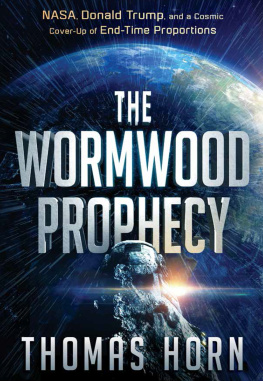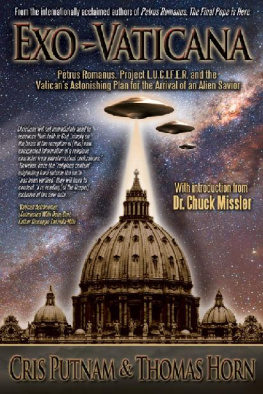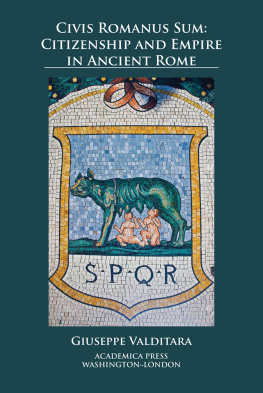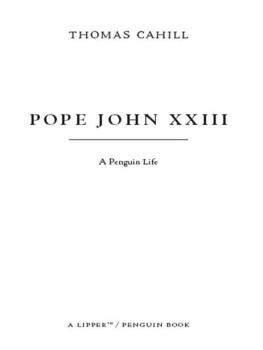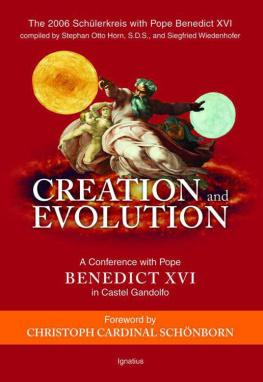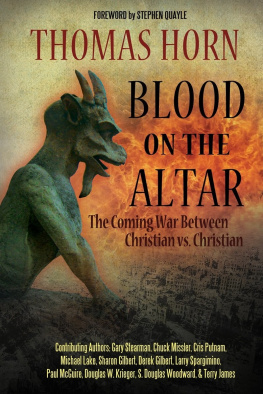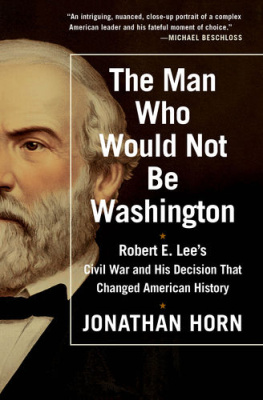Thomas Horn - Petrus Romanus: The Final Pope Is Here
Here you can read online Thomas Horn - Petrus Romanus: The Final Pope Is Here full text of the book (entire story) in english for free. Download pdf and epub, get meaning, cover and reviews about this ebook. year: 2012, publisher: Defender, genre: Religion. Description of the work, (preface) as well as reviews are available. Best literature library LitArk.com created for fans of good reading and offers a wide selection of genres:
Romance novel
Science fiction
Adventure
Detective
Science
History
Home and family
Prose
Art
Politics
Computer
Non-fiction
Religion
Business
Children
Humor
Choose a favorite category and find really read worthwhile books. Enjoy immersion in the world of imagination, feel the emotions of the characters or learn something new for yourself, make an fascinating discovery.

- Book:Petrus Romanus: The Final Pope Is Here
- Author:
- Publisher:Defender
- Genre:
- Year:2012
- Rating:3 / 5
- Favourites:Add to favourites
- Your mark:
- 60
- 1
- 2
- 3
- 4
- 5
Petrus Romanus: The Final Pope Is Here: summary, description and annotation
We offer to read an annotation, description, summary or preface (depends on what the author of the book "Petrus Romanus: The Final Pope Is Here" wrote himself). If you haven't found the necessary information about the book — write in the comments, we will try to find it.
Petrus Romanus: The Final Pope Is Here — read online for free the complete book (whole text) full work
Below is the text of the book, divided by pages. System saving the place of the last page read, allows you to conveniently read the book "Petrus Romanus: The Final Pope Is Here" online for free, without having to search again every time where you left off. Put a bookmark, and you can go to the page where you finished reading at any time.
Font size:
Interval:
Bookmark:

Petrus Romanus
Thomas Horn
Cris Putnam
Defender
Defender
Crane, MO 65633
2012 by Thomas Horn
A collaborative work by Thomas Horn and Cris Putnam.
All rights reserved. Published 2012.
Printed in the United States of America.
ISBN 13: 9780984825615
A CIP catalog record of this book is available from the Library of Congress.
Cover illustration and design by Daniel Wright.
All Scripture quotations from the King James Version; in cases of academic comparison, those instances are noted.
Table of Contents
Preface
A book about a medieval prophecy is necessarily a book of history. The papacy is arguably the most ancient institution in existence today. While we seek to define the historical context of the matters at hand, the scope is enormous. Accordingly, we must paint in broad brush strokes and will inevitably fail to present events with a balance acceptable to all readers. First, we offer the big picture. The papacy is an outgrowth from the early Christian Church, which sprung up from the events of the first century centered on Jesus of Nazareth, as recorded in the ancient collection of documents known as the New Testament. There were certainly some great and godly men associated with Catholicism over the years, but we believe Rome became a juggernaut intoxicated by its own power. Our standard of truth is the Bible. Christianity is defined by the New Testament and all claimants to the title Christian are necessarily evaluated by it.
The formation of the New Testament cannon (rule of faith) was more organic that organized and largely in response to an onslaught of heretical books falsely attributed to the apostles. Scholars detect that the cannon was in evidence long before it was declared by any magisterial council. For instance, John Barton used data on the number of times the Early Church fathers quoted the various books and there is a clear distinction in frequency of usage between the New Testament books and the non-canonical works. Hence, the argument that the formation of the cannon was a spiritual work of God by his providential authentication gains credence over the brute authority of magisterial councils.
Historically, the New Testament is an utterly unique and revolutionary collection of ancient documents. Unlike other so-called holy books, it explicitly claims divine inspiration: All scriptureis given by inspiration of God, and is profitable for doctrine, for reproof, for correction, for instruction in righteousness (2 Ti 3:16). While some may wish to debate the intricacies of this, it is not the purpose of this book to argue that case, rather it is presupposed. Another revolutionary aspect of the New Testament which is often overlooked is its utterly unique socio-political worldview. Contrary to every other religious system, the New Testament documents present an inimitable picture of a composite society. We mean this in the sense that the world is defined as being made up of two groups of people as to the Gospel: believers and unbelievers. Believers are charged to do the work of ambassadors entering into hostile territory, peacefully appealing to the unbeliever to be reconciled to God (2 Corinthians 5:20). This is to be done by humble example and persuasion, never by threats or coercion. Jesus greatest opponents were the religious leaders; you might even think of them as the popes, bishops, and cardinals of first-century Judaism.
Similarly, the church and state are considered separate and Christians are commanded to live peacefully even within hostile governments (cf. Rom 13). Consider that, prior to Jesus Christ, this concept of a composite society was unheard of in all of human experience. In all previous societies, religion and the state were a unified magisterium. Even in the Old Testament, the church and state were one as a theocratic and then monarchial system and priesthood. While there was a separation between the duties and rights of the priest and the king, the Jewish nation was a unified sacral society. The New Testament discarded the sequestered priesthood for the universal priesthood of the believer under Jesus Christ. Nowhere are church leaders called priests. They are called elders or overseers and are encouraged by Peter to act, Neither as being lords over Gods heritage, but being ensamples to the flock (1 Pe 5:3).
Today, Islam is an obvious illustration of a sacral system with its system of sharia law. In countries like Iran, Saudi Arabia, or Yemen, religious laws are enforced by the state and you risk your life if you accept the Gospel. Similarly, in China or North Korea, the atheistic state cult will jail, torture, and execute Christians as political dissidents. In Hinduism, the caste system mandates your position in society. This is the darkness of non-Christian religions. It also reveals the distinctiveness of the kingdom instituted by Christ. Jesus announced the kingdom of God is at hand (Mark 1:15), but simultaneously that this kingdom is not of this world (John 18:36). In addition, Satans temptation of Christ involved a shortcut to possess all the kingdoms of this world which he rejected (cf. Mat 4:9). Accordingly, we believe that the separation of church and temporal power is essential to pure Christianity. The New Testament is the only religious book that endorses a composite society over a sacral society. Accordingly, there has never been a true Christian nation or Christendom and there will not be one until Christ returns. We believe this teaching is vigorously attacked and obfuscated by Satan. It was virtually lost for most of history and it took the Protestant reformation to begin bringing it back to light.
It is because of that reformation that America is also a composite society in that it advocates the separation of church and state. This was largely from the plight of Puritans and others who fled the state-mandated religions of England and Rome. Of course, in America it was originally conceived to keep churches free from the state more than keeping prayer out of schools and other such distortions. The original motivation was freedom of religion, not freedom from religion. That being said, what made America great was its Christian roots and New-Testament worldview. The Bible teaches us to be model citizens. It extols the virtues of hard work, loving your neighbor (even your enemies), and paying your taxes. Jesus illustrated the composite worldview perfectly when he taught, Render therefore unto Caesar the things which are Caesars; and unto God the things that are Gods (Mt 22:21). When considering the weight of that teaching, it is important to remember how utterly opposed to Christ the Roman government was. Even so, believers were taught to live in this church-state/world dichotomy as His ambassadors. However, there is a very real enemy working against us and we are in a state of war.
Font size:
Interval:
Bookmark:
Similar books «Petrus Romanus: The Final Pope Is Here»
Look at similar books to Petrus Romanus: The Final Pope Is Here. We have selected literature similar in name and meaning in the hope of providing readers with more options to find new, interesting, not yet read works.
Discussion, reviews of the book Petrus Romanus: The Final Pope Is Here and just readers' own opinions. Leave your comments, write what you think about the work, its meaning or the main characters. Specify what exactly you liked and what you didn't like, and why you think so.

